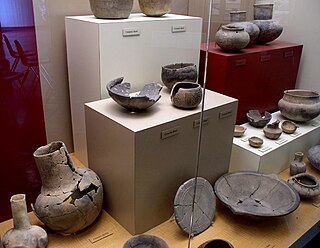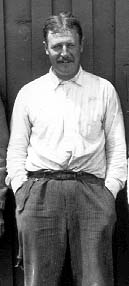| Periods in Mesoamerican history |
|---|
 |
The chronology of Pre-Columbian Mesoamerica is usually divided into the following eras:
| Periods in Mesoamerican history |
|---|
 |
The chronology of Pre-Columbian Mesoamerica is usually divided into the following eras:
One of the most enduring classifications of archaeological periods & cultures was established in Gordon Willey and Philip Phillips' 1958 book Method and Theory in American Archaeology. They divided the archaeological record in the Americas into 5 phases. These are:
| Paleo-Indian (10,000–3500 BCE) | Honduras, Guatemala, Belize, obsidian and pyrite points, Iztapan | |||
| Archaic (3500–1800 BCE) | Agricultural settlements, Tehuacán | |||
| Preclassic (Formative) (2000 BCE–250 CE) | The start of states. The first large scale ceremonial architecture, development of cities. (Olmecs; Unknown culture in La Blanca and Ujuxte, Monte Alto culture) | Early Preclassic | Olmec area: San Lorenzo Tenochtitlan; Central Mexico: Chalcatzingo; Valley of Oaxaca: San José Mogote. The Maya area: Nakbe, Cerros | 2000–1000 BCE |
| Middle Preclassic | Olmec area: La Venta, Tres Zapotes; Maya area: El Mirador, Izapa, Lamanai, Xunantunich, Naj Tunich, Takalik Abaj, Kaminaljuyú, Uaxactun; Valley of Oaxaca: Monte Albán | 1000–400 BCE | ||
| Late Preclassic | Maya area: Uaxactun, Tikal, Edzná, Cival, San Bartolo, Altar de Sacrificios, Piedras Negras, Ceibal, Rio Azul; Central Mexico: Teotihuacan; Gulf Coast: Epi-Olmec culture | 400 BCE–200 CE | ||
| Classic (200–900 CE) | Height of the nation-states. (Classic Maya centers, Teotihuacan, Zapotecs) | Early Classic | Maya area: Calakmul, Caracol, Chunchucmil, Copán, Naranjo, Palenque, Quiriguá, Tikal, Uaxactun, Yaxha; Teotihuacan apogee; Zapotec apogee. | 200–600 CE |
| Late Classic | Maya area: Uxmal, Toniná, Cobá, Waka', Pusilhá, Xultún, Dos Pilas, Cancuen, Aguateca; Central Mexico: Xochicalco, Cacaxtla, Cholula; Gulf Coast: El Tajín and Classic Veracruz culture | 600–900 CE | ||
| Terminal Classic | Maya area: Puuc sites – Uxmal, Labna, Sayil, Kabah | 800–900/1000 CE | ||
| Postclassic (900–1519 CE) | Collapse of many of the great nations and cities of the Classic Era. Formation of new kingdoms and empires. (Aztec, Toltec, Purépecha, Mixtec, Totonac, Pipil, Itzá, Kowoj, K'iche', Kaqchikel, Poqomam, Mam) | Early Postclassic | Tula, Mitla, Tulum, Topoxte, Chichen Itza | 900–1200 CE |
| Late Postclassic | Tenochtitlan, Cempoala, Tzintzuntzan, Mayapán, Ti'ho, Utatlán, Iximche, Mixco Viejo, Zaculeu | 1200–1519 CE | ||
| Post Conquest (Until 1697 CE) | Central Peten: Tayasal, Zacpeten | |||

The three-age system is the periodization of human prehistory into three time-periods: the Stone Age, the Bronze Age, and the Iron Age, although the concept may also refer to other tripartite divisions of historic time periods. In history, archaeology and physical anthropology, the three-age system is a methodological concept adopted during the 19th century according to which artefacts and events of late prehistory and early history could be broadly ordered into a recognizable chronology. C. J. Thomsen initially developed this categorization in the period 1816 to 1825, as a result of classifying the collection of an archaeological exhibition chronologically – there resulted broad sequences with artefacts made successively of stone, bronze, and iron.

The archaeology of the Americas is the study of the archaeology of the Western Hemisphere, including North America (Mesoamerica), Central America, South America and the Caribbean. This includes the study of pre-historic/Pre-Columbian and historic indigenous American peoples, as well as historical archaeology of more recent eras, including the Trans-Atlantic slave trade and European colonization.

Processual archaeology is a form of archaeological theory. It had its beginnings in 1958 with the work of Gordon Willey and Philip Phillips, Method and Theory in American Archaeology, in which the pair stated that "American archaeology is anthropology, or it is nothing", a rephrasing of Frederic William Maitland's comment: "My own belief is that by and by, anthropology will have the choice between being history, and being nothing." The idea implied that the goals of archaeology were the goals of anthropology, which were to answer questions about humans and human culture. This was meant to be a critique of the former period in archaeology, the cultural-history phase in which archaeologists thought that information artifacts contained about past culture would be lost once the items became included in the archaeological record. Willey and Phillips believed all that could be done was to catalogue, describe, and create timelines based on the artifacts.

In the classification of the archaeological cultures of North America, the Archaic period in North America, taken to last from around 8000 to 1000 BC in the sequence of North American pre-Columbian cultural stages, is a period defined by the archaic stage of cultural development. The Archaic stage is characterized by subsistence economies supported through the exploitation of nuts, seeds, and shellfish. As its ending is defined by the adoption of sedentary farming, this date can vary significantly across the Americas.

Oneota is a designation archaeologists use to refer to a cultural complex that existed in the Eastern Plains and Great Lakes area of what is now occupied by the United States from around AD 900 to around 1650 or 1700. Based on the classification defined in Gordon Willey and Philip Phillips' 1958 book Method and Theory in American Archaeology, the Oneota culture belongs to formative stage. The culture is believed to have transitioned into various Siouan cultures of the protohistoric and historic times, such as the Ioway. A long-accepted ancestry to the Ho-chunk has yet to be conclusively demonstrated.

In the sequence of cultural stages first proposed for the archaeology of the Americas by Gordon Willey and Philip Phillips in 1958, the Lithic stage was the earliest period of human occupation in the Americas, as post-glacial hunter gatherers spread through the Americas. The stage derived its name from the first appearance of Lithic flaked stone tools. The term Paleo-Indian is an alternative, generally indicating much the same period.
In archaeology, the general meaning of horizon is a distinctive type of sediment, artefact, style, or other cultural trait that is found across a large geographical area from a limited time period. The term derives from similar ones in geology, horizon or marker horizon, but where these have natural causes, archaeological horizons are caused by humans. Most typically, there is a change in the type of pottery found and in the style of less frequent major artefacts. Across a horizon, the same type of artefact or style is found very widely over a large area, and it can be assumed that these traces are approximately contemporary.

Alfred Vincent Kidder was an American archaeologist considered the foremost of the southwestern United States and Mesoamerica during the first half of the 20th century. He saw a disciplined system of archaeological techniques as a means to extend the principles of anthropology into the prehistoric past and so was the originator of the first comprehensive, systematic approach to North American archaeology.
Gordon Randolph Willey was an American archaeologist who was described by colleagues as the "dean" of New World archaeology. Willey performed fieldwork at excavations in South America, Central America and the Southeastern United States; and pioneered the development and methodology for settlement patterns theories. He worked as an anthropologist for the Smithsonian Institution and as a professor at Harvard University.
Several periodisations are employed for the periodisation of the Indus Valley Civilisation. While the Indus Valley Civilisation was divided into Early, Mature, and Late Harappan by archaeologists like Mortimer Wheeler, newer periodisations include the Neolithic early farming settlements, and use a stage–phase model, often combining terminology from various systems.

Several chronologies in the archaeology of the Americas include a Formative Period or Formative stage etc. It is often sub-divided, for example into "Early", "Middle" and "Late" stages.

In archaeological cultures of North America, the classic stage is the theoretical North and Meso-American societies that existed between AD 500 and 1200. This stage is the fourth of five stages posited by Gordon Willey and Philip Phillips' 1958 book Method and Theory in American Archaeology.

In the classification of the archaeology of the Americas, the Post-Classic stage is a term applied to some pre-Columbian cultures, typically ending with local contact with Europeans. This stage is the fifth of five archaeological stages posited by Gordon Willey and Philip Phillips' 1958 book Method and Theory in American Archaeology.
Philip Phillips was an influential archaeologist in the United States during the 20th century. Although his first graduate work was in architecture, he later received a doctorate from Harvard University under advisor Alfred Marston Tozzer. His first archaeological experiences were on Iroquois sites, but he specialized in the Mississippian culture, especially its Lower Mississippi Valley incarnation.
The Belle Glade culture, or Okeechobee culture, is an archaeological culture that existed from as early as 1000 BCE until about 1700 CE in the area surrounding Lake Okeechobee and in the Kissimmee River valley in the Florida Peninsula.

The Fort Walton Mound (8OK6) is an archaeological site located in present-day Fort Walton Beach, Florida, United States. The large platform mound was built about 850 CE by the Pensacola culture, a local form of the Mississippian culture. Because of its significance, the mound was designated a National Historic Landmark in 1964.
Prehistoric technology is technology that predates recorded history. History is the study of the past using written records. Anything prior to the first written accounts of history is prehistoric, including earlier technologies. About 2.5 million years before writing was developed, technology began with the earliest hominids who used stone tools, which they first used to hunt food, and later to cook.

Several chronologies in the archaeology of the Americas include an Archaic Period or Archaic stage etc. It is often sub-divided, for example into "Early", "Middle" and "Late", or alternatively "Lower" and "Upper", stages. The dates, and the characteristics of the period called "Archaic" vary between different parts of the Americas. Sometimes also referred to as the "Pre-Ceramic stage" or period, it followed the Lithic stage and was superseded by the Formative stage, or a Preformative stage. The typical broad use of the terms is as follows:

Negative painting is a painting technique where the background is painted dark, allowing the lighter color to appear as the design. There have been at least four methods proposed as to how negative painting was done. It is widely found on painted pottery, but it is speculated that “the first objects with negative painting may not have been pottery, but rather textiles or gourds.”